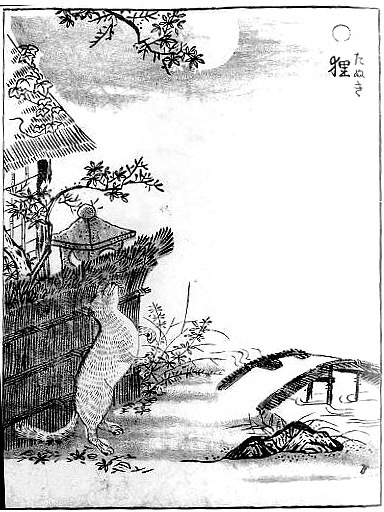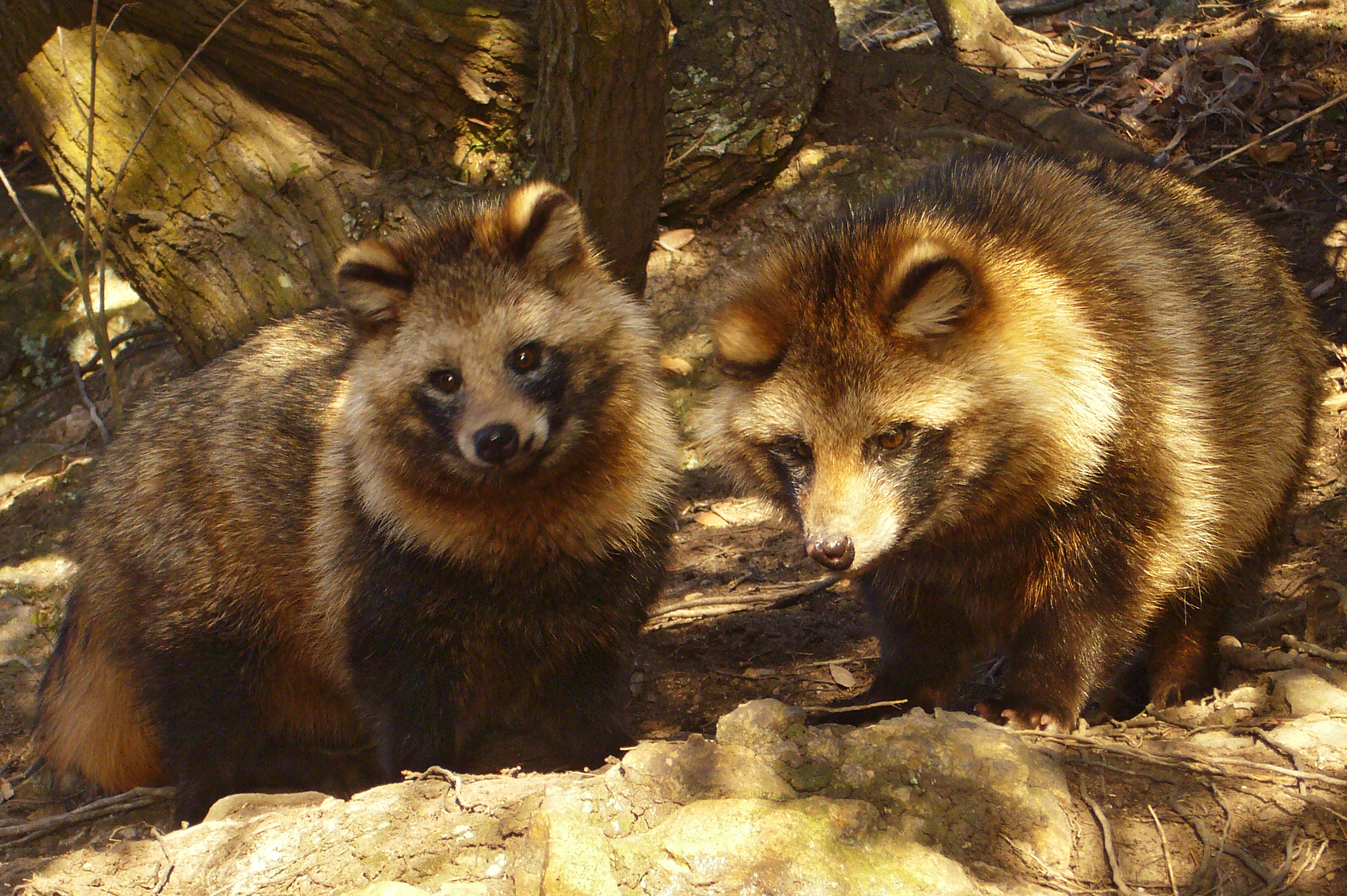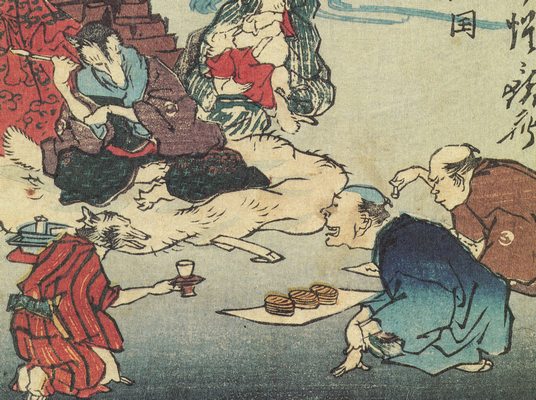|
Bake-danuki
''Bake-danuki'' () are a kind of ''yōkai'' (supernatural beings) found in the classics and in the folklore and legends of various places in Japan, commonly associated with the Japanese raccoon dog or ''tanuki''. Although the tanuki is a real, extant animal, the bake-danuki that appears in literature has always been depicted as a strange, even supernatural animal. In some regions of Japan, ''bake-danuki'' are reputed to have abilities similar to those attributed to kitsune (foxes): they can shapeshift into other things or people, and can possess human beings. Many legends of ''tanuki'' exist in the Sado Islands of Niigata Prefecture and in Shikoku, and among them, like the Danzaburou-danuki of Sado, the Kinchō-tanuki and Rokuemon-tanuki of Awa Province (Tokushima Prefecture), and the Yashima no Hage-tanuki of Kagawa Prefecture, the ''tanuki'' that possessed special abilities were given names, and even became the subject of rituals. Apart from these places, ''tanuki'' are ... [...More Info...] [...Related Items...] OR: [Wikipedia] [Google] [Baidu] |
Japanese Raccoon Dog
The Japanese raccoon dog (''Nyctereutes viverrinus'', or ''tanuki'' ()) is a species of canid that is endemic to Japan. It is one of two species in the genus '' Nyctereutes'', alongside the common raccoon dog (''N. procyonoides''), of which it is considered to be a subspecies by some taxonomic authorities. Japanese raccoon dogs have had a significant role in Japanese folklore since ancient times. They are reputedly mischievous and jolly, masters of disguise and shapeshifting, but somewhat gullible and absent-minded. The animals are common in Japanese art, particularly as statues. Description The Japanese raccoon dog has a smaller stomach and shorter fur of lesser insulation value than mainland raccoon dogs. A white color type is rare. In mainland Japan, oculocutaneous albinism is caused by a mutation in the third and fifth exon of the TYR nucleotide sequence, which is responsible for melanin pigmentation. Behavior The Japanese raccoon dog is mainly nocturnal. It vocali ... [...More Info...] [...Related Items...] OR: [Wikipedia] [Google] [Baidu] |
Mujina
is an old Japanese term primarily referring to the Japanese badger, but traditionally to the Japanese raccoon dog (''tanuki''), causing confusion. Adding to the confusion, it may also refer to the introduced masked palm civet, and in some regions badger-like animals or Japanese raccoon dog are also called ''mami''. Appearance The ''mujina'' is said to be a raccoon-faced creature in its natural form, with the main body being that of a Japanese badger. In some parts of Japan, they are incorrectly referred to as the ''tanuki'', to whom they are closely related in terms of appearance as well as actions- even though the ''tanuki'' are biologically related to the fox and dog.Reeves, David. “A Brief Introduction to Aoki Rosui and Annotated Translation of his Text Otogi Hyaku Monogatari.” ''Masters Theses'', 240, 2015, pp. 37-40. . Accessed 25 Nov 2022. The ''mujina'' in specific are known to be able to inflate their bellies, creating music by drumming on it whilst singing. S ... [...More Info...] [...Related Items...] OR: [Wikipedia] [Google] [Baidu] |
Yashima No Hage-tanuki
is a , who appears in the legends of Yashima, Takamatsu, Kagawa Prefecture. He is also called Tasaburō-tanuki (太三郎狸), Yashima no Hage, and Yashima no Kamuro (屋島の禿). He is counted as one of the "three famous tanuki of Japan", along with Danzaburou-danuki of Sado and Shibaemon-tanuki of Awaji. He is also famous due to his appearance in the Studio Ghibli animated movie, '' Heisei Tanuki Gassen Ponpoko''. 村上2011年、126-127頁。 Legend In the past, there was a tanuki who was wounded by a fatal arrow shot, but was saved by Taira no Shigemori. To pay his debt of gratitude, the tanuki swore to protect the Taira clan. This wounded tanuki's descendant is said to be Yashima no Hage-tanuki. 赤塚1995年、99–100頁。 After the Taira clan was ruined, Hage-tanuki became the protector deity of Yashima-ji, the 84th temple on the Shikoku 88-temple pilgrimage. His skill at transformation was called the best in Japan, and he achieved the rank of supreme commande ... [...More Info...] [...Related Items...] OR: [Wikipedia] [Google] [Baidu] |
Bunbuku Chagama
is a Japanese folktale or fairy tale about a '' tanuki'' (raccoon dog), that uses its shapeshifting powers to reward its rescuer for his kindness. Overview The fairy tale version has been translated into English as "The Accomplished and Lucky Teakettle" (1871) by Mitford and as "The Wonderful Tea Kettle" (1886) in the crepe-paper book series published by T. Hasegawa. The raccoon dog is ill-treated as a tea-kettle at a temple and sold off; it later performs a dance and tightrope walking routine, and the subsequent owner turned showman acquires great wealth. In most folk tale versions, the raccoon dog or fox transforms into a kettle so that its human friend or benefactor can make profit by selling the fake kettle, typically to a priest. In legend, Bunbuku chagama is the name of a tea kettle owned by priest Shukaku who turned out to be an ancient raccoon dog or '' mujina'', the supposed kettle still on view at temple which Shukaku served. Etymology One suggested hypothe ... [...More Info...] [...Related Items...] OR: [Wikipedia] [Google] [Baidu] |
Danzaburou-danuki
is a bake-danuki passed down in stories on Sado Island, particularly in Aikawa, Niigata, Aikawa and Sado, Niigata, Niigata. In Sado, tanuki were called "mujina (狢)", thus he was also referred to as Danzaburou-mujina (団三郎狢). In the Ukiyo-e, its name was written as 同三狸." Together with the Shibaemon-tanuki of Awaji Island, and the Yashima no Hage-tanuki of Kagawa Prefecture, they form the "Japanese raccoon dog#In folklore and tradition, three famous tanuki" of Japan. Legend The supreme commander of the tanuki on Sado Island, most tales of Danzaburou focus on his trickery of humans. He would create wall-like structures to block people's paths at night, fooled people with mirages and sold leaves from trees by making them look as if they were made of gold. He also created mirages to lure people into his lair (said to be a hole in the ground or a cellar), making it appear as a splendid estate. If he ever became ill, Danzaburou would disguise himself as a human and visit ... [...More Info...] [...Related Items...] OR: [Wikipedia] [Google] [Baidu] |
Kachi-kachi Yama
, also known as ''Kachi-Kachi Mountain'' and ''The Farmer and the Badger'', is a Japanese Folklore, folktale in which a ''bake-danuki, tanuki'' is the villain, rather than the more usual boisterous, well-endowed alcoholic. Story The trouble-making ''tanuki'' As the story goes, a man caught a troublesome ''tanuki'' in his fields, and tied it to a tree to kill and cook it later. When the man left for town, the ''tanuki'' cried and begged the man's wife who was making some ''mochi'', a sweet rice dish, to set him free, promising he would help her. The wife freed the animal, only to have it turn on her and kill her. The ''tanuki'' then planned a foul trick. Using its shapeshifting abilities, the ''tanuki'' disguised itself as the wife and cooked a soup, using the dead woman's flesh. When the man came home, the ''tanuki'' served him the soup. After the meal, the ''tanuki'' reverted to its original appearance and revealed its treachery before running off and leaving the poor man in ... [...More Info...] [...Related Items...] OR: [Wikipedia] [Google] [Baidu] |
Awa Tanuki Gassen
The (The Tanuki War of Awa) is a Japanese legend about a great war between ''bake-danuki'' (magical Japanese raccoon dog, tanuki) that supposedly occurred in the late Edo period in Awa Province (Tokushima), Awa Province (now Tokushima Prefecture). It is also known as the and the (The Kinchō Tanuki War). It is one of the most famous tanuki legends among the many found in Shikoku, and often considered the most renowned tanuki story from Tokushima. The story is believed to have originated in the late Edo period. Literary records exist in three handwritten manuscripts from the late Edo period: (''Chikagoro Furudanuki Chinsetsu''), (''Furudanuki Kinchō Giyū Chinsetsu''), and (''Kinchō Isshōki''), though their exact dates are unknown. The legend gained widespread circulation through kōdan (narrative storytelling) transcriptions published in Meiji era, Meiji 43 (1910): (''Shikoku Kidan Jissetsu Furudanuki Gassen''), (''Tsudaura Dai-kessen''), and (''Higaino Tomurai Gassen' ... [...More Info...] [...Related Items...] OR: [Wikipedia] [Google] [Baidu] |
Uji Shūi Monogatari
is a collection of Japanese tales written around the beginning of the 13th century. The author is unknown, and it may have been revised several times. The title references the '' Uji Dainagon Monogatari'', a book which no longer exists. The Dainagon of Uji was Minamoto no Takakuni. The work is classified as setsuwa literature. Following in the footsteps of '' Konjaku Monogatarishū'', it is the representative setsuwa work of the Kamakura period. Contents The story is made up of 197 tales spanning 15 volumes. Of the 197, 80 of the stories also appear in the ''Konjaku Monogatarishū''. The preface states that it contains tales from Japan, India, and China. However, few of them are original, with many stories containing common elements from earlier works such as ''Konjaku Monogatarishū''. Contents include a number of characters ranging from nobles to commoners and tales ranging from everyday stories to the obscure and comical. Several of the stories were used as a basis fo ... [...More Info...] [...Related Items...] OR: [Wikipedia] [Google] [Baidu] |
Chinese Character
Chinese characters are logographs used to write the Chinese languages and others from regions historically influenced by Chinese culture. Of the four independently invented writing systems accepted by scholars, they represent the only one that has remained in continuous use. Over a documented history spanning more than three millennia, the function, style, and means of writing characters have changed greatly. Unlike letters in alphabets that reflect the sounds of speech, Chinese characters generally represent morphemes, the units of meaning in a language. Writing all of the frequently used vocabulary in a language requires roughly 2000–3000 characters; , nearly have been identified and included in '' The Unicode Standard''. Characters are created according to several principles, where aspects of shape and pronunciation may be used to indicate the character's meaning. The first attested characters are oracle bone inscriptions made during the 13th century BCE in w ... [...More Info...] [...Related Items...] OR: [Wikipedia] [Google] [Baidu] |
China
China, officially the People's Republic of China (PRC), is a country in East Asia. With population of China, a population exceeding 1.4 billion, it is the list of countries by population (United Nations), second-most populous country after India, representing 17.4% of the world population. China spans the equivalent of five time zones and Borders of China, borders fourteen countries by land across an area of nearly , making it the list of countries and dependencies by area, third-largest country by land area. The country is divided into 33 Province-level divisions of China, province-level divisions: 22 provinces of China, provinces, 5 autonomous regions of China, autonomous regions, 4 direct-administered municipalities of China, municipalities, and 2 semi-autonomous special administrative regions. Beijing is the country's capital, while Shanghai is List of cities in China by population, its most populous city by urban area and largest financial center. Considered one of six ... [...More Info...] [...Related Items...] OR: [Wikipedia] [Google] [Baidu] |







